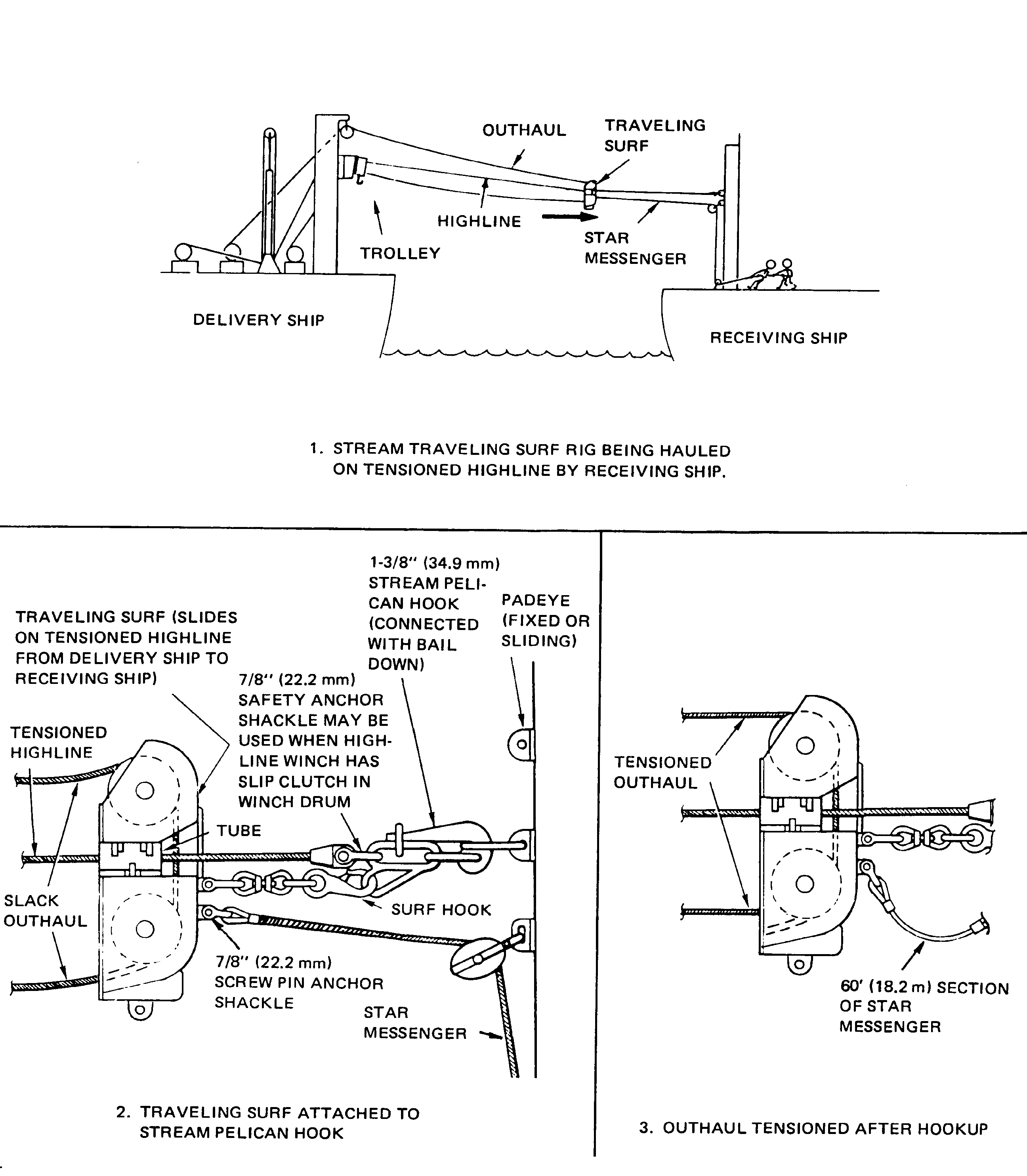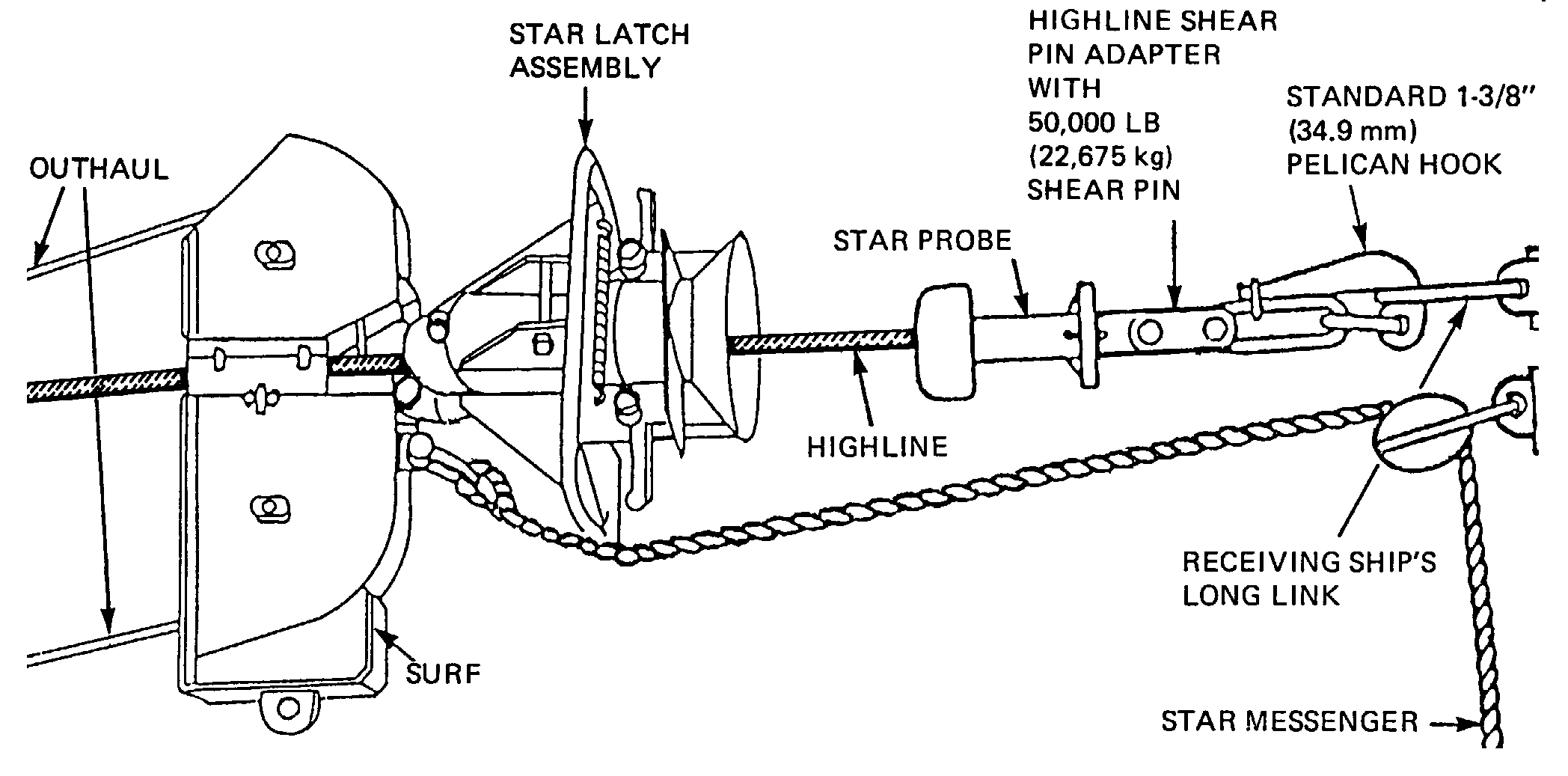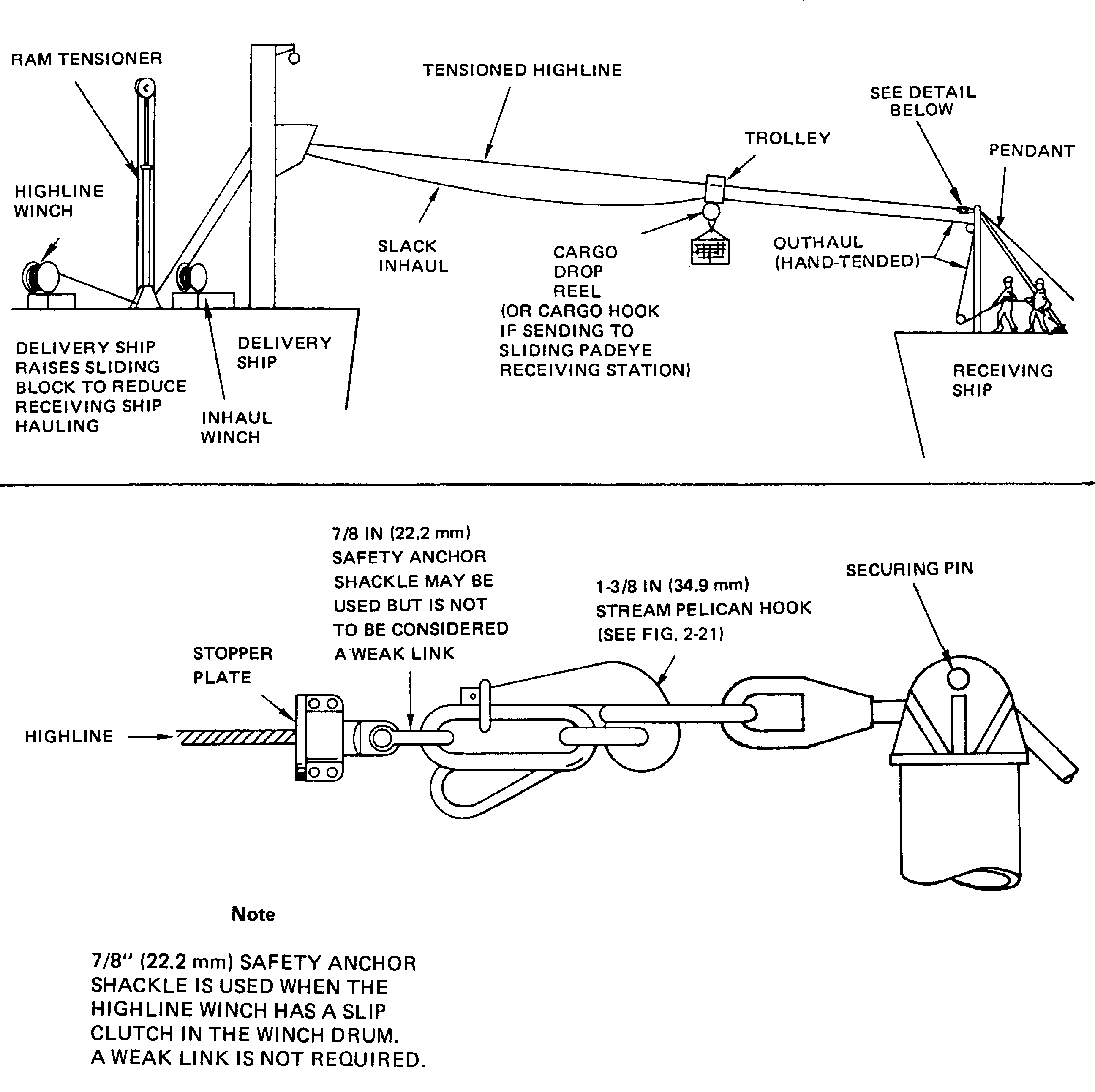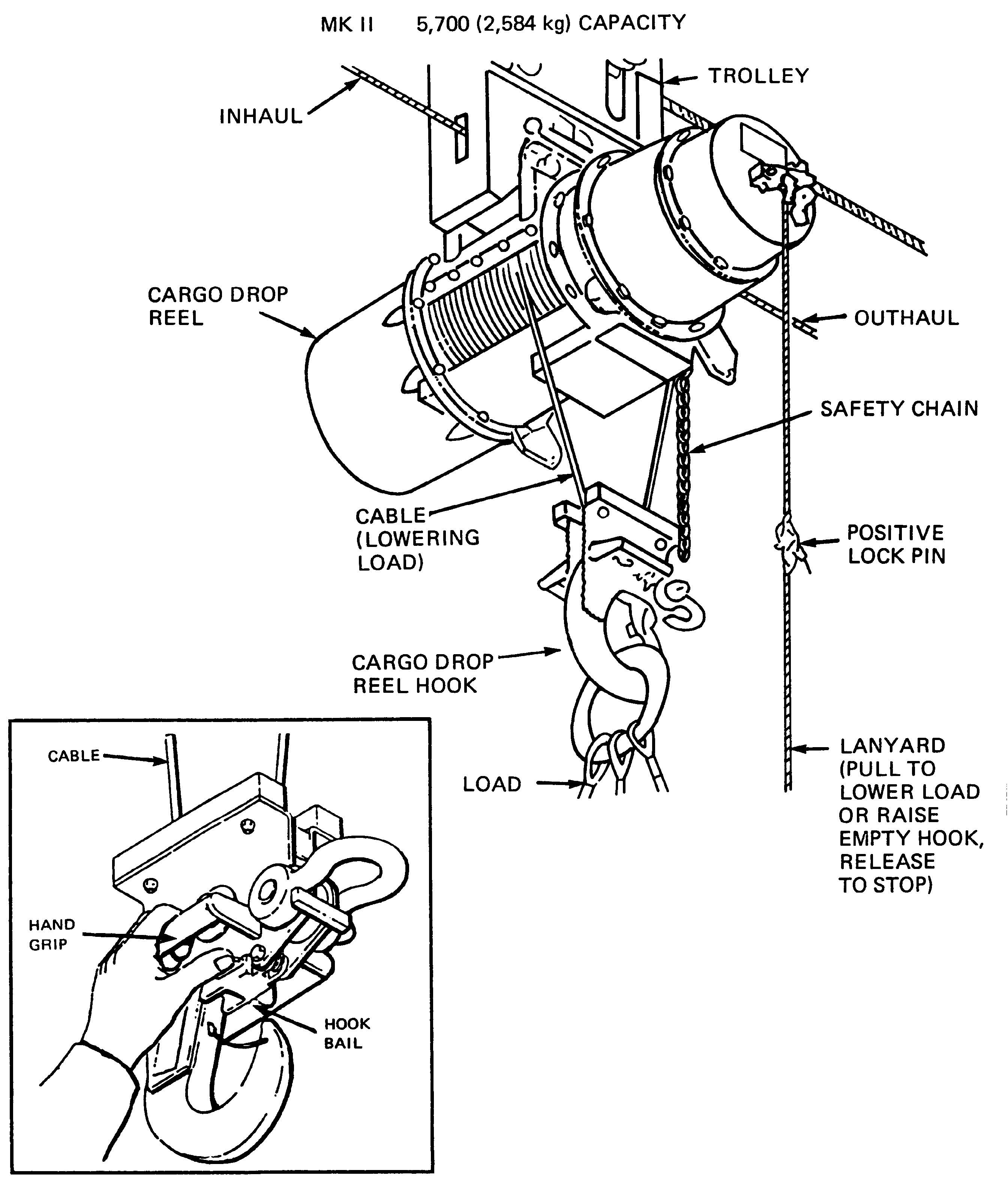 Deck Officer
Deck Officer  Deck Officer
Deck Officer
INFORMATION SHEET
STAR/SURF/MK II CARGO DROP REEL/HEAVY LIFT
Information Sheet 1.12
INTRODUCTION
The transfer of cargo and missiles at sea is vital to your ship's ability to conduct sustained operations at sea. The safety of both the UNREP personnel and the cargo is one of your responsibilities as the First Lieutenant/Deck Officer.
REFERENCES
(a) NWP 4-01.4
INFORMATION
A. CHARACTERISTICS OF THE THREE STREAM CARGO CONFIGURATIONS
1. STREAM using a traveling SURF block only
a. A SURF block is the Standard Underway Replenishment Fixture that is used to fairlead the tensioned outhaul line from the receiving station back to the delivery ship. At the start of the UNREP, the SURF block is sent along the tensioned highline to the receiving ship where it is manually connected with a pelican hook to the ship's padeye, sliding padeye, or pendant.
b. The SURF block consists of two high speed roller bearing sheaves, one on top of the other
inside a steel block.
c. Personnel must be sent aloft to attach this rig with fixed padeye and pendant receiving
stations.
2. STREAM using a SURF block with a STAR rig attached
a. A STAR (SURF Traveling Actuated Remotely) rig consists of a STAR latch assembly and a STAR probe. The STAR latch assembly is bolted to the traveling SURF block and mates automatically with the STAR probe on the receiving ship at the start of the UNREP. When disconnecting, the STAR latch assembly is disconnected remotely via a releasing line fairled from the latching arms.
b. The STAR latch assembly housing contains two spring loaded latches for mating with the STAR probe. The STAR probe is made up of a head, tube and fin mounted guide which fits over the highline end fitting.
c. The STAR rig provides for automatic hookup of the SURF and eliminates the need to send personnel aloft for these purposes.
3. STREAM using a hand-tended outhaul line
a. This method does not use a SURF block, but rather, the load is hauled to the receiving ship by a messenger line tended by the receiving ship's linehandlers.
b. This method is used when an outhaul winch is not available on either ship or when the receiving ship's attachment point cannot support an all-tensioned rig.

Figure 1.12-1 STREAM with SURF
a. SURF block - slides on the tensioned highline from delivery ship to the receiving ship.
b. SURF hook - attaches the SURF block to the STREAM pelican hook.
c. STREAM pelican hook - used to secure the highline to the long link on the receiving station's fixed padeye, sliding padeye or pendant.
d. STAR messenger - the main line used to assist in hauling any basic rig between ships. The preferred location for handling the STAR messenger is forward and inboard of the rig.
2. STREAM using a SURF block with a STAR rig attached

Figure 1.12-2 STREAM-SURF with STAR Latch Assembly
a. SURF block - slides on the tensioned highline from the delivery ship to the receiving ship. Once connected to the receiving station, this fixture fairleads the tensioned outhaul line back to the delivery ship.
b. STAR latch assembly - is bolted onto the traveling SURF. The STAR latch assembly and the STAR probe mate automatically when the rig is passed to the receiving station.
c. Highline probe fitting - the highline fits into the probe then the probe mates with the STAR latch assembly.
d. Standard pelican hook - used to secure the highline to the long link on the receiving station's fixed padeye, sliding padeye, or pendant.
e. Brummel hooks - attach releasing line to the STAR messenger. Brummel hooks are made up of a closed ring and a split ring (a ring cut to have a small opening) or two split rings and can be quickly attached and removed.
f. STAR messenger - the main line used to assist in hauling any basic rig between ships. The preferred location for handling the STAR messenger is forward and inboard of the rig.
g. Shackle - attaches lines to other devices (e.g. padeyes). Screw pin shackles are used in
applications where it may be necessary to break down the shackles quickly. Safety anchor
shackles are used in areas where the shackle will not be taken apart quickly.
a. STREAM pelican hook - used to secure the highline to the long link on the receiving station's fixed padeye, sliding padeye or pendant.
b. Light weight trolley - travels along the tensioned highline and is used for light weight loads. Attachments allow trolley to carry cargo.
c. Hand tended outhaul - the outhaul line is used to move the trolley towards the receiving ship. This line is hand-tended by personnel aboard the receiving ship.
C. PROCEDURE FOR PASSING STREAM RIGS
1. STREAM using a traveling SURF block only
a. The delivery ship sends over the shot line with the messenger attached.
b. The receiving ship installs the messenger in the fairlead blocks and continues to haul in the messenger until the highline is aboard.
c. The receiving ship uses a pelican hook to attach the highline to its kingpost, sliding padeye, or pendant.
d. The delivery ship tensions the highline using safety precautions outlined in NWP 4-01.4.
e. The receiving ship continues to haul in the messenger to pull the sliding SURF block across the tensioned highline. When the SURF is two-blocked (i.e., resting tightly) against the highline end fitting, attach the SURF hook to the bail on the bottom of the STREAM pelican hook.
f. The STREAM system is now ready for transfer.

Figure 1.12-3 STREAM w/ Hand Tended Outhaul
2. STREAM using a SURF block with a STAR rig attached
a. The delivery ship sends over the shot line with the messenger attached.
b. The receiving ship installs the messenger in the fairlead blocks and continues to haul in the messenger until the highline is aboard.
c. The receiving ship uses a pelican hook to attach the highline to its kingpost, sliding padeye, or pendant.
d. The delivery ship tensions the highline using safety precautions outlined in NWP 4-01.4.
e. The receiving ship continues to haul in the messenger to pull the SURF and STAR latch assembly across the tensioned highline.
f. When the STAR latch assembly comes in contact with the head of the STAR probe, the latches will momentarily tilt open and then snap back closed after they have passed the head of the STAR probe. This indicates that the STAR rig is latched onto the STAR probe.
g. The STREAM system is now ready for transfer.
3. STREAM using a hand-tended outhaul line
a. The delivery ship sends over the shot line with the messenger attached.
b. The receiving ship installs the messenger in the fairlead blocks and continues to haul in the messenger until the highline is aboard.
c. The receiving ship uses a pelican hook to attach the highline to its kingpost, sliding padeye, or pendant.
d. The delivery ship tensions the highline using safety precautions outlined in NWP 4-01.4.
e. The STREAM system with hand-tended outhaul is now ready for transfer.
D. STREAM CONFIGURATIONS AND THEIR ASSOCIATED TRANSFER HARDWARE
1. SURF - can be rigged to a sliding padeye, fixed padeye, or pendant receiving station.
2. STAR - can be rigged to a sliding padeye, fixed padeye, or pendant receiving station.
3. MK II cargo drop reel - can be rigged to a fixed padeye or a pendant receiving station.
E. STREAM LOAD LOWERING METHODS
1. Sliding padeye - loads up to the full capacity of the STREAM rig so it can be sent to or returned from a sliding padeye. The padeye is powered to move up or down in a guide track mounted on the kingpost. The sliding padeye provides good load control.
2. MK II cargo drop reel - used to lower a load from a trolley on a tensioned highline. The cargo drop reel does not provide the same amount of load control as the sliding padeye, but it does allow the load to be lowered under the control of the receiving station.

Figure 1.12-4 MK II Cargo Drop Reel
F. TRANSFER OF AMMUNITION AND MISSILES WITH STREAM
1. Ammunition transfer equipment
a. Mk 6 missile transfer dolly - used to transfer non-containerized missiles and boosters.
b. Cargo drop reel - installed to the STREAM trolley.
c. Two methods of missile VERTREP are currently used:
(1) In the first method, missiles and boosters are carried in containers such as Mk 183, Mk 199 or Mk 200.
(2) In the second method, missiles are transferred in the Mk 6 or the Mk 30 missile dolly.
d. Palletized Ordnance - conventional ammunition is normally transferred on pallets.
2. Transfer Procedure
a. Use mechanical handling and strikedown equipment whenever they are available. They will reduce the work involved in manually lifting the ammunition.
b. Transfer missiles and components simultaneously, so that if the replenishment operation is interrupted, missiles that are already on board will be complete for operational purposes.
c. The order of the missiles and boosters is specified by the combatant, as determined by the strikedown system.
d. The direction that the missile faces during transfer is also specified by the combatant, since the forward end of the missile must face the launcher after the missile has passed through the strikedown system.
e. When transferring awkward or sensitive missiles, use tag lines and steadying lines or MK 1 strongback to prevent the load from rotating and to control the pendulum action of the load.
f. To expedite transfer of Standard MR missiles, the delivery ship must properly align the rail components with a standard rail gauge. This should be done prior to sending the dolly to the receiving ship for either onloading or offloading of missiles.
g. If the receiving ship does not have the unloading area or capability to handle full pallet loads, the ammunition ship should send over partial pallet loads.

Figure 1.12-5 MK 6 Transfer Dolly
G. FUNCTIONS AND CHARACTERISTICS OF HEAVY LIFT EQUIPMENT
1. Gullwing (MK 5) strongback
a. The MK 5 strongback is an adjustable sling for transfer of heavy equipment.

2. Adjustable pallet sling
a. This is a two-loop wire rope sling for lifting loaded pallets without using a cargo net.
b. Lifting thimbles provide the attachment points for the hoisting sling used to carry the load by the helicopter.
c. There are four models of this sling, identified by color coding, the difference being their size:
(1) MK 85 - red - for loads 13 to 31 inches high.
(2) MK 86 - black - for loads 29 to 40 inches high.
(3) MK 87 - green - for loads 36 to 50 inches high.
(4) MK 100 - yellow - for loads 48 to 70 inches high.
3. Cargo container
a. Pallet with collapsible wire mesh sides used for transfer of loose or odd shaped items, such as small arms ammo and sonobuoys.
4. Mk 105 Hoisting slings
a. Primarily used for VERTREP.
b. Consist of a pendant and legs of various sizes with a capacity of 6000 lbs.
H. PERSONNEL TRANSFER
a. Personnel can be transferred between ships at short notice using synthetic highline.
2. Equipment
a. Highline - 4" double braided, polyester at least 350 ft used to support trolley.
(1) A Newco type thimble will be spliced into the delivery end with a 1" shackle attached.
b. Inhaul - 3" plated polyester line 350 feet minimum.
(1) An eye is spliced to the outboard end
(2) A 3/4" or 7/8" anchor safety shackle is dipped through the eye of the inhaul then attached to the inboard side of the trolley. The inhaul is used to the haul trolley back to ship.
c. Outhaul/Messenger
(1) Use a STAR messenger, if available; if not, make a 5" eye into a 3" line that will be attached to the outboard side of the transfer trolley. It will be used to deliver the highline and haul chair to the receiving ship.
d. Transfer Chair
(1) Aluminum chair - that attaches to the highline trolley used to transfer personnel. Equipped with floatation material.
e. Trolley
(1) A movable block used to suspend and move the transfer chair along the highline. Also equipped with flotation gear.